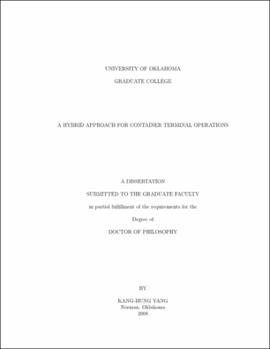| dc.contributor.advisor | Guan, Yongpei | |
| dc.creator | Yang, Kang-hung | |
| dc.date.accessioned | 2019-04-27T21:19:21Z | |
| dc.date.available | 2019-04-27T21:19:21Z | |
| dc.date.issued | 2008 | |
| dc.identifier | 99100100602042 | |
| dc.identifier.uri | https://hdl.handle.net/11244/318425 | |
| dc.description.abstract | The container trade has increased dramatically in the late decade. Forecast projections indicate that this trend will continue in the future. Thus, effective and efficient operations become more essential for container terminals in the transportation network. This study aims to analyze different operational problems in container terminals to provide effective and efficient policies for on-site operations. The three main topics in this study are the berth allocation problem (BAP), the quay crane scheduling problem (QCSP), and the inspection problem. Instead of analyzing these problems separately, I study the combined problems. | |
| dc.description.abstract | The first study addresses BAP and the inspection problem, the secondstudy addresses QCSP, and the third study addresses the combinedproblem of BAP and QCSP. The first study estimates a reasonable service rate for the inspection operation, so that the inspection will not be the bottleneck of the system. Theoretical lower bound of the inspection service rate is provided through different | |
| dc.description.abstract | deterministic berthing heuristics. For the stochastic job processing | |
| dc.description.abstract | time cases, the inspection service rate can be acquired by a simulation model with a heuristic approach. In this study, the | |
| dc.description.abstract | simulation approach and the heuristic approach are combined by the embedded simulation technique, and this combined approach is | |
| dc.description.abstract | successfully applied for BAP with inspection. The second study addresses QCSP. I consider the problem that has one vessel and | |
| dc.description.abstract | multiple cranes. Exact and heuristic solution approaches are developed for the problem. A mathematical model with a time-space | |
| dc.description.abstract | network flow sub-structure and non-crossing constraints is established for small size problems. Lagrangian relaxation approach is used to obtain tight lower bounds and near-optimal solutions for medium size problems. For large size problems, I adapt the heuristic approach. The theoretical analysis results show that the error bound of the designed heuristics is no more than 100%. Numerical experiments are performed to evaluate efficiency and effectiveness of the solution approaches for the problem. The third study focuses on a general problem that combines BAP and QCSP, named BAQCP. I develop a mathematical formulation and use a heuristic approach to solve BAQCP. Two heuristics, preemption and non-preemption, are developed. Both theoretical and numerical results demonstrate the efficiency and effectiveness of these two heuristics. In order to further improve the heuristic results, I combine the exact solution approach provided by the mathematical formulation and the heuristic approach. The heuristic solutions are set to be the initial inputs for the mathematical model. Numerical experiments show that this combined approach makes the improvement of the solution quality within a reasonable execution time, and that they can be applied for practical cases in the real world. | |
| dc.format.extent | 118 pages | |
| dc.format.medium | application.pdf | |
| dc.language | en_US | |
| dc.relation.requires | Adobe Acrobat Reader | |
| dc.subject | Container terminals--Automation | |
| dc.subject | Business logistics--Mathematical models | |
| dc.subject | Heuristic | |
| dc.subject | Problem solving | |
| dc.title | A Hybrid Approach for Container Terminal Operations | |
| dc.type | text | |
| dc.type | document | |
| dc.thesis.degree | Ph.D. | |
| ou.group | College of Engineering::School of Industrial Engineering | |
